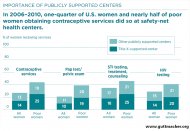
WHO RECEIVES PUBLICLY FUNDED SERVICES?
- In 2014, 7.8 million women—39% of all women in need of publicly subsidized care—received publicly funded contraceptive services from clinics (5.3 million) or from private doctors serving Medicaid enrollees (2.5 million).
- Teenagers represented 15% of contraceptive clients served by safety-net health centers in 2014; nearly one million women younger than 20 were served by these centers.
WHERE ARE PUBLICLY FUNDED SERVICES PROVIDED?
- In 2010, subsidized family planning services were provided at 8, 409 safety-net health centers—3, 165 (38%) were federally qualified health centers, 2, 439 (29%) were health department clinics, 1, 324 (16%) were other clinics, 817 (10%) were Planned Parenthood centers and 664 (8%) were hospital clinics.
- More than one-third (36%) of women who obtained contraceptive care from safety-net centers in 2010 received services from Planned Parenthood sites, 27% from health department clinics, 16% from federally qualified health centers, 13% from other clinics and 8% from hospital outpatient facilities.
- In 2010, 82% of U.S. counties had at least one safety-net health center providing family planning services, and 72% of counties had at least one Title X-funded center.
- In 2014, there were more than 4, 100 Title X-supported centers. That year, 71% of all women served by publicly funded centers (3.7 million) were served by centers that received some funding from Title X.
WHAT SERVICES DO PUBLICLY FUNDED CENTERS OFFER?
- More than half of centers (54%) reported offering clients at least 10 of 13 possible reversible contraceptive methods in 2010, an increase from 35% of centers in 2003.
- Oral contraceptives, injectables (e.g., Depo Provera) and condoms were provided by more than nine in 10 safety-net health centers, and 80% offered emergency contraceptive pills.
- In 2010, more than half of centers (57%) reported being unable to stock certain contraceptive methods due to cost.
- The availability of long-acting reversible contraceptive methods increased significantly between 2003 and 2010. IUD provision increased from 57% to 63%, and the implant, which was unavailable in 2003, was offered by 39% of centers in 2010.
- As of 2010, centers with a reproductive health focus offered a greater range of contraceptive methods onsite and were more likely to have protocols to help clients initiate and continue using methods, compared with centers focusing on primary care.
- Similarly, Title X–funded centers provided a higher average number of contraceptive methods and were more likely to have protocols to enable easy initiation and continuation of methods, compared with centers not receiving Title X funding.
- In 2010, 39% of centers offered same-day appointments to new contraceptive clients, and 39% of centers offered extended hours in the evenings or on weekends. Among all centers, the average wait for an appointment was just over five days.
- Virtually all safety-net health centers provided pregnancy testing in 2010, and the vast majority offered HIV testing (92%), testing (97%) and treatment (95%) for other STIs, and HPV vaccinations (87%).
- Although safety-net health centers typically focus on serving women, most also offer services to men. For instance, 9% (more than 300, 000) of family planning clients served by Title X centers in 2014 were male. Some 63% of Title X–funded centers offered STI treatment to men whose female partner had tested positive, and 57% provided STI services to men, regardless of their partners’ status. Additionally, in 2010, half of all centers reported that men received contraceptive services directly.
PUBLICLY FUNDED CENTERS’ ROLE AS SAFETY-NET PROVIDERS
- More than six in 10 women who obtained care at a publicly funded center providing contraceptive services in 2006–2010 considered the center their usual source of medical care. For four in 10 women who obtained care at a family planning center specializing in the provision of contraceptive care, that center was their only source of health care.
- One in four women who obtained a contraceptive service in 2006–2010 did so at a publicly funded center. Of these, 9% obtained their care from an independent family planning center, such as a Planned Parenthood clinic or other facility that focuses on providing contraceptive care; 8% did so at a community clinic; 6% did so at a health department clinic; and 5% did so at a hospital outpatient or school-based clinic.
- Fourteen percent of all women who obtained contraceptive services in 2006–2010, and 25% of all poor women who received a contraceptive service, did so at a site that received funding through the Title X program. Ten percent of women who received a Pap test or pelvic exam in that period did so at a Title X–funded site.
- Eighteen percent of women who received testing, treatment or counseling for an STI in 2006–2010 did so at a Title X–funded site. Fourteen percent of women who were tested for HIV did so at a Title X–supported site.
Source: www.guttmacher.org
|
What To Do When Someone Dies: A simple step-by-step guide for family members, personal representatives and executors with day-to-day time-lines and ... probate and financial topics are covered. Book (CreateSpace Independent Publishing Platform) |
Related posts:























